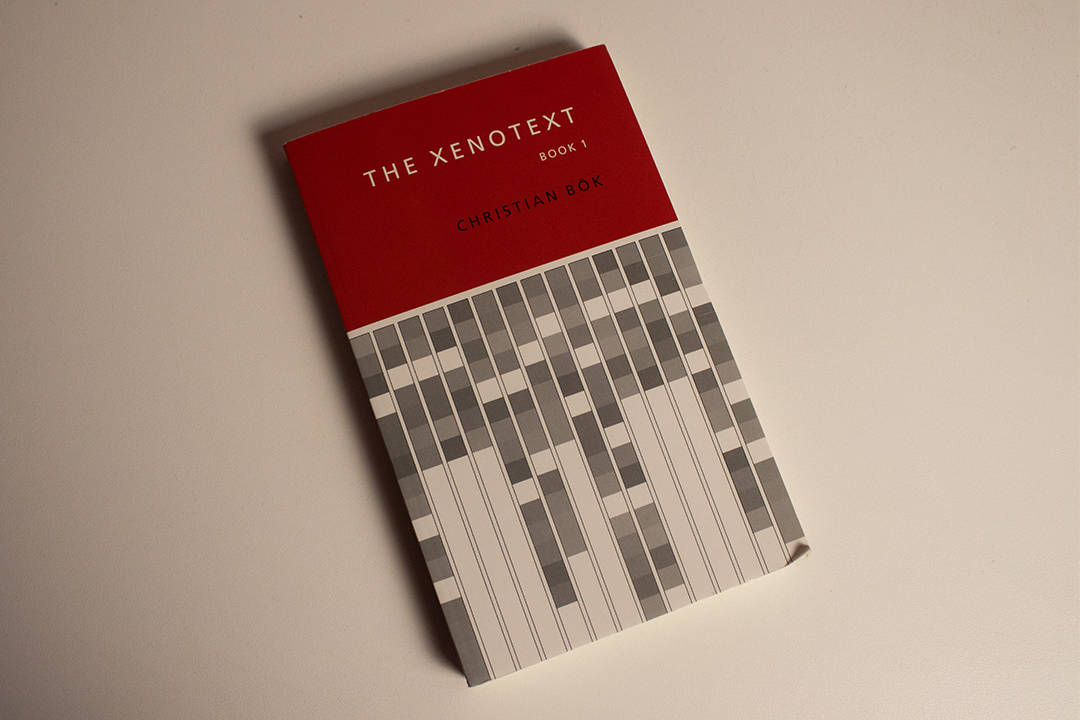“Must the universe be so pitiless as to immolate all its offspring at birth?”
From the beginning, I was haunted. Canadian poet Christian Bök’s book of experimental poetry, The Xenotext: Book 1, begins by immersing you in the world of “The Late Heavy Bombardment.” Bök envisions an “omnicide,” the destruction of all life. He summons monsters from the depths of the ocean, the fires of war and Hell, and galactic events that could wipe out life on Earth if not for coincidence. Xenotext is a text that will be read in two settings: now and forever from now.
How Christian Bök encodes his poem in biological information
“DNA is an actual casino of signs, preserving, within a random series of letters, the haphazard alignment of acids and ideas.”
DNA and RNA are both grouped into “codons,” which are groups of three nucleotides each. A nucleotide is a type of molecule that forms DNA and RNA, consisting of a sugar, a phosphate, and a base with nitrogen. In living organisms and even viruses, genetic information in DNA is transcribed into RNA, which is then translated into proteins.
There are 64 possible codons that each correspond to a single amino acid, the building block of proteins. Bök randomly chose 26 codons and assigned each to one of the 26 letters of the alphabet, allowing him to use codons to construct words and sentences.
Using the codon alphabet, each letter in Bök’s poem “Orpheus” corresponds to a DNA codon. Bök assembled a DNA sequence enciphered with these letters of the poem and inserted it into an E. coli bacterium. When the E. coli transcribed the DNA into RNA, Bök read the RNA transcript as the second poem, “Eurydice,” using the same letter-codon pairings he’d originally assigned.
In Greek mythology, Orpheus and Eurydice are wed until a snakebite kills Eurydice. When he sees Orpheus grieving, Hades, the god of the underworld, allows Orpheus to take Eurydice from the land of the dead under the condition that he wouldn’t look back at Eurydice. Upon seeing the land of the living, Orpheus looks back at Eurydice in joy. Then, she disappears.
Bök’s challenge is one of both bioengineering and cryptography: he must simulate the DNA to RNA transcription on his supercomputer to see if it can produce a meaningful “Eurydice” sonnet from the RNA transcript that corresponds to his “Orpheus” DNA sequence. He then sends the results to a lab to test on a live bacterium what he had simulated on his supercomputer. He has already tested it on E. coli because it’s easier to work with, but the ultimate goal is to do this in D. radiodurans, which is one of the most radiation-resistant organisms — a “deathless bacterium.” This is the biogenesis of art — but what about the art itself?
Today, I sit at my desk and turn the pages. Hopefully, when you and I are both long gone, someone will take a second look at the proteins that certain D. radiodurans produce and will be able to regenerate “Eurydice.”
The Xenotext itself is a collection of sonnets written such that it can be enciphered into the DNA and still produce a meaningful message with the RNA result. Bök created this project with the hope of preserving the information forever, or at least in a forever that is meaningful for humanity.
“Colony Collapse Disorder”: A small apocalypse
In The Queer Art of Failure, Jack Halberstam advocates for “creative anthropomorphism,” subverting the “singularity of the human” by writing stories about “real or fantasized beasts.” Bök takes this to the extreme, dedicating the second chapter of Xenotext to bees. It is named “Colony Collapse Disorder,” after the horrifying “pandemic syndrome” in which worker bees leave their hives without returning — an apocalypse in miniature.
Although several factors might contribute to colony collapse disorder, the article cited by Xenotext proposes that neonicotinoids, a group of pesticides, may aggravate it. The subsequent poems don’t just observe the bees but are from the bees’ perspective. Sonnets 6–10, entitled “On the Armies of the Realm,” show bee civilization in terms that would put Sparta to shame, describing orphaned children enlisted in the “army,” participating in riots, crusades, and despotism.
Bök places sonnets about Virgil’s tales of bees from The Georgics after this set of poems — in Bök’s imagining, bees fight, labour, and lounge as the Roman poets do. Is what Bök is doing creative anthropomorphism? That is one way of looking at it — his sonnets about bees envision non-human animals with the trappings of civilization, both good and bad.
However, in the philosopher-biologist Donna Haraway’s Staying with the Trouble: Making Kin in the Cthulucene, she rejects anthropocentrism entirely, instead suggesting, among other things, to think of both ecology and art through the concept of ‘sympoiesis’. Haraway defines sympoiesis simply as “making-with.” One of her most vivid examples of sympoiesis is the relationship between the Hawaiian bobtail squid and its symbiont, Vibrio fischeri, which infects juvenile squids so that they can develop a luminescent pouch necessary for hunting. This is a “sympoietic collaboration.”
Bök is also working sympoietically with bacteria. Rather than sustain life, Bök wants to sustain information, and, maybe more importantly, sustain poetry. He collaborates with the bacterium, working on “Orpheus” while the bacterium will, eventually, spit out the “Eurydice” RNA transcript, which will be made into proteins, hopefully outlasting our civilization through galactic chance.
Unlike the real Orpheus, I hope that Bök doesn’t look back.


